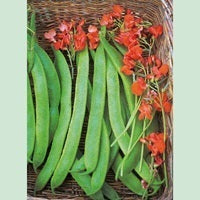Runner Bean Lady Di
Runner Bean Lady Di
Packet Size: 24 seeds
Couldn't load pickup availability
Lady Di is a real star in the garden — and not just for the name! This heat-tolerant variety produces long, smooth, slender pods that are slow to fill with seed, giving you a nice window to pick them at their best. Even when the pods reach their full 30cm length, they stay impressively tender. You might get a bit of fibre at that size, but stringy? Not really — which makes them great for casseroles and stews too.
On top of that, the plants are covered in bright red flowers that bring a splash of colour and draw in the pollinators. It’s no wonder Lady Di has earned an RHS Award of Garden Merit — it’s a real all-rounder.
SOW: in late spring after frost danger has passed. We like to start runners in pots, seed depth 25-50mm. When they show signs of wanting to climb harden off and plant out. You can plant them in situ but put your canes in place first! They like rich soil, dig in organic matter in the spring to boost your beans!
GROW: they like a cane each set at about 20cm apart, you may need to encourage them to twine but they soon get the hang of it. You can pinch out the first growing tip when 25cm high to encourage more bushy growth. Cropping starts in about 14 weeks. Although Lady Di is drought tolerant, they don’t like parched conditions, water regularly if possible.
ENJOY: keep picking and more beans will grow! We tend to pick beans on the young side, but stringless Lady Di will give you nice firm beans at a larger size. Fresh sliced runners take about 10mins to steam, try with a splash of lemon juice or a sprinkle of cheese. Runner Beans are perfect to freeze: slice (blanch if possible) & bag into meal sized amounts.
Wildlife-friendly
- Runner bean flowers are a magnet for bumblebees, especially long-tongued species like Buff-tailed and White-tailed Bumblebees, which are skilled at reaching their nectar.
- They also attract honeybees and various solitary bees, helping boost pollination and bean yields.
- Hoverflies visit the flowers for nectar, while their larvae help control aphid populations in your garden.
- Leaves and stems can host beneficial predatory insects like ladybirds and parasitic wasps that keep pests in check.
- Birds such as sparrows and finches may feed on fallen beans or seeds late in the season, supporting local wildlife food chains.

Collapsible content
Sowing
- Apr
- May
- Jun
Harvesting / Flowering
- Jul
- Aug
- Sep

